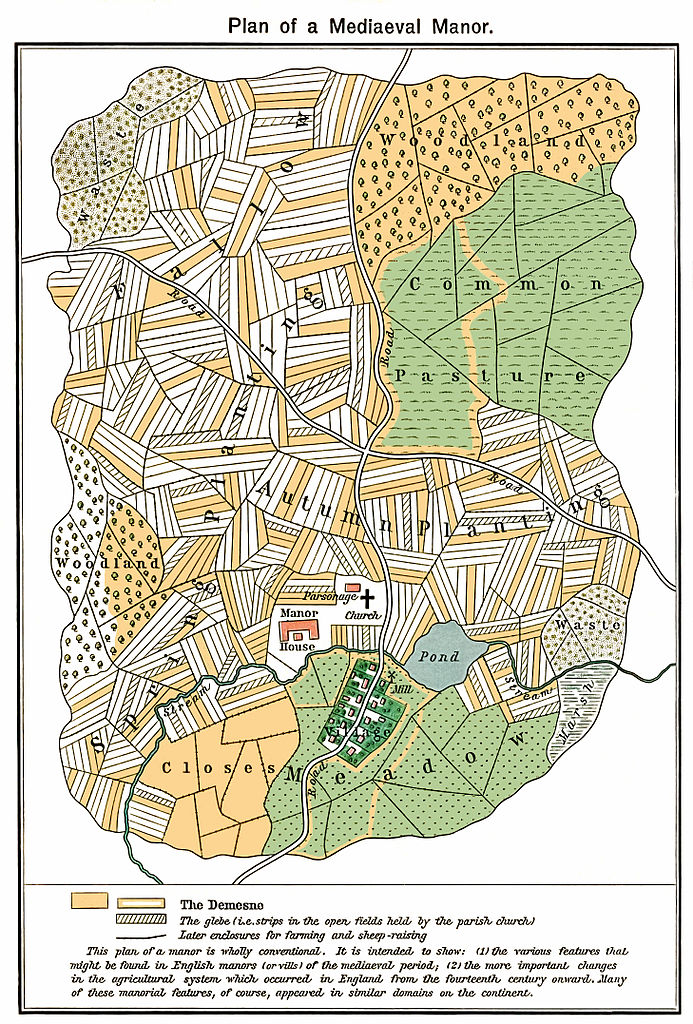What's the deal with enclosures?
by Jason Crawford · March 26, 2020 · 3 min read
In the history of English agriculture there is this thing called the enclosure movement, and it’s apparently a big deal. I’m going to try to explain what I understand about it and what I don’t. Epistemic status: rough; I’ve just learned this stuff, and I have many open questions. High likelihood of at least one non-trivial mistake in here. (I’m working with the garage door up.)
Here is the context. In the Middle Ages many (although not all) villages used an “open-field” system. In this system, a village would have perhaps three large fields of arable land, rotating between different crops and fallow (known as the fallow system). The fields would be divided into many small strips. Each peasant farmer would be assigned several strips, distributed throughout all three fields. My understanding is that the strips might even get reassigned each year. In addition to this, there were some lands used in common, such as pastures for grazing livestock. Typically there was a feudal lord who provided (or was supposed to provide) protection for the village, who had a larger house or even a castle and some of his own land, and who received some form of taxes and/or rents from the villagers in the form of labor, produce, and/or money. In some villages, I think, a religious authority, such as a monastery, substituted for a temporal one.

The “enclosure” movement was the gradual transition away from this system, to a system of basically private property. Parts of the lands previously used in common, or strips of the open fields, were “enclosed”. The term is both literal, referring to physical boundary markers such as hedges or ditches, and legal, referring to the transition of the property rights in the land to a simple freeholding (i.e., what we think of today as simply “owning” land).
In England, enclosure happened very gradually, over several centuries, starting in the 1200s and mostly finishing up by the 1800s. Enclosure was (not too surprisingly) at least somewhat politically controversial at the time, and may have been at least part of the motivation for some peasant revolts. It’s also controversial among academics today, in part because Marx told a story in which enclosure was basically about land being stolen from the peasants, forcing them into working-class jobs in the towns and cities and creating the proletariat, which the capitalists exploited. There is also a story about the enclosures of the Tudor period in particular amounting to evicting the tenant serfs, who became vagrants en masse; Pseudoerasmus reports that this is a myth. The political aspects are actually not what concern me here, and I don’t plan to get very deep into them.
But there’s a lot about this story I don’t yet understand. First, why was the open-field system ever used? I mean, having some pasture in common isn’t that surprising, since of course no one would have owned it before there was any settled society, and as long as that arrangement was working there would have been no strong motivation to change it. In that sense, it isn’t the commons that requires an explanation, it’s the enclosures. But the system of having many little strips seems bizarrely complicated. One explanation was that this reduced potential unfairness, if some strips were not as fertile as others, but this doesn’t quite add up for me.
Wikipedia suggests (citing a history of open-field farming) that areas with dense soil needed heavy plows pulled by teams of horses or oxen, and peasants couldn’t afford either plows or draft animals, so these needed to be shared property (although it’s unclear to me how this sharing might have worked). But this also doesn’t feel like it’s significant enough to be the whole or even the main answer.
Second, why did the enclosure movement happen? Stretching as it did across several centuries, it’s quite possible there wasn’t a single cause, of course. The sources I’ve read hint at a few things. One is that in a certain era, economic demand may have shifted away from grain and towards meat and wool, and part of the enclosure movement was driven by a desire to convert more land into pasture for livestock.
But another explanation seems to be that the open-field system was inefficient, and that enclosure led to more agricultural productivity. Fair enough, but how exactly? Some sources reference the tragedy of the commons, except that I haven’t read anything that actually claims that there was a significant problem of, for example, overgrazing in the common pastures. There are general references to enclosure allowing farmers to adopt better practices, but I haven’t seen exactly what these were. The only specific inefficiency of the open-field system I’ve read is that the peasants might have wasted a lot of time traveling between their homes and their scattered strips, but this hardly seems decisive.
The one thing I have a lead on in terms of “better practices” is a new crop rotation involving turnips and clover. I’m going to read about that next. But if anyone knows of a good explanation of the inefficiencies of the open-field system or the productivity improvements of enclosures, point me to it.
Comment on Reddit
